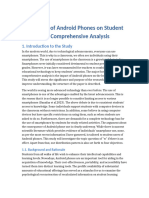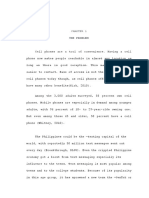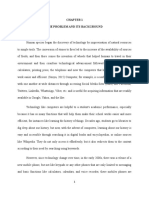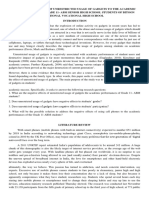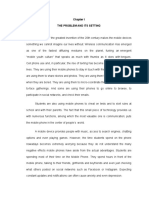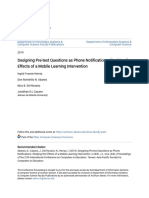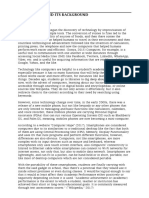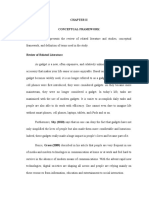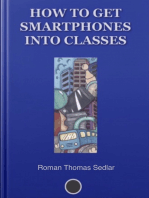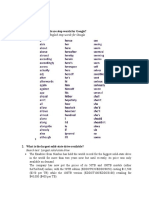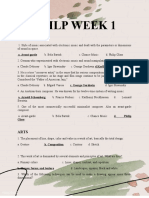RRL
RRL
Uploaded by
Hazel L. ansulaCopyright:
Available Formats
RRL
RRL
Uploaded by
Hazel L. ansulaOriginal Description:
Copyright
Available Formats
Share this document
Did you find this document useful?
Is this content inappropriate?
Copyright:
Available Formats
RRL
RRL
Uploaded by
Hazel L. ansulaCopyright:
Available Formats
Mobile learning is becoming a crucial tool in this era of face-to-face shutdown of education, and
however the whole process currently faces a significant deficiency due to the kind of cognitive load that
does exist and its relation with mobile device screen display size. It is well-established that certain
screen sizes are more effective than others. A research conducted by Alasmari (2020), revealed that
students having smartphones with small screen sizes get the least cognitive load, followed by large-
screen tablet users who get the second least cognitive load, whereas the small-screen tablets and large
screen smartphones create the most cognitive load. On the other hand, students have a great impact of
cognitive load on their performance and efficiency. According to the findings, students having small
screen size smartphones got the lowest cognitive load.
Mangen (2013) conducted an experiment on primary school children, to look at the nature of the
electronic media used by students to see if that has an effect on learning outcomes. Using a specific
testing format, students undertook a comprehension test immediately after studying a text either using
a mobile phone or a lap-top. The decision on what device to use was the students’ own with most opting
to use a mobile phone (68% of the students). Analysis of answers from the comprehension test after the
study period showed a significant decrease in student performance when they used mobile phones
compared to lap-tops (p < 0.05). This study shows that despite the move by many universities to employ
mobile telephone apps to enhance learning and engagement by students, the type of device used may
be crucial.
The development of digital media technology in the twenty-first century has led to a rapid
development of moving images as an educational medium. Higher education is experiencing a paradigm
shift in how video-based learning resources are delivered. A paper by Bennett, Hand, and Allan (2008)
investigated the effect of mobile phone screen size (1.65 inches- 2.75 inches) on video based learning.
Findings indicate that regardless of the screen size of a mobile phone, students tended to have a
positive overall opinion of m-learning and watching the video significantly increased their knowledge of
the subject area. However, if an m-learning environment that relies heavily on video based material is
displayed on a mobile device with a small screen (1.65 inches), such as an average mobile phone, then
the effectiveness of the learning experience may be inhibited. An experiment on the impact of large
displays and cognitive factors influenced virtual reality performances shows that some users, depending
on their visual attention abilities, improve their performances when working with large displays. This
experiment shows also that performances gain depend on the nature of the task. The results permit to
consider large display as a cognitive aid for difficult interaction tasks or for users with low visual
attention abilities. This type of cognitive approach can help designers to make choice of display
configuration depending on users’ cognitive abilities and tasks. (Tyndiuk, Lespinet-Najib, Thomas, and
Schlick, 2004)
You might also like
- Community Development Breaking The Cycle of Poverty PDFDocument2 pagesCommunity Development Breaking The Cycle of Poverty PDFCarlos40% (5)
- The Effects of Gadgets On Academic Performance of Students Thesis PDFDocument13 pagesThe Effects of Gadgets On Academic Performance of Students Thesis PDFRenor Sagun100% (1)
- The Association For Science Ed - Teaching Secondary Physics-Hodder Education (2021)Document271 pagesThe Association For Science Ed - Teaching Secondary Physics-Hodder Education (2021)KNEWTON EducationNo ratings yet
- Practical Research 2Document35 pagesPractical Research 2Leah Mae VicenteNo ratings yet
- BRM Research Paper Group - 5Document9 pagesBRM Research Paper Group - 5AniketNo ratings yet
- ApenDocument11 pagesApenearl9rivera-830280No ratings yet
- Chapter L: Background of The Study As Technology Continues To Develop, Mobile Devices Have BecomeDocument9 pagesChapter L: Background of The Study As Technology Continues To Develop, Mobile Devices Have Becomeferlyn dumapeNo ratings yet
- The Impact of Android Phones on Student Learning_ A Comprehensive AnalysisDocument17 pagesThe Impact of Android Phones on Student Learning_ A Comprehensive Analysisolusegunshinaayomi1No ratings yet
- Final GROUP 2 CHAPTER 1,2, and ReferenceDocument9 pagesFinal GROUP 2 CHAPTER 1,2, and ReferenceCarmel C. GaboNo ratings yet
- The ProblemDocument40 pagesThe ProblemAllen Timtiman BisqueraNo ratings yet
- Smartphones and Students Academic PerforDocument39 pagesSmartphones and Students Academic PerforEhra Jiang KangraejoonNo ratings yet
- The Correlation of Using Smart Phones in Academic Performance of The Grade 12 Students of San Isidro National High SchoolDocument30 pagesThe Correlation of Using Smart Phones in Academic Performance of The Grade 12 Students of San Isidro National High Schooladamson62472100% (2)
- Group 1 CHAPTER 1-5Document26 pagesGroup 1 CHAPTER 1-5Regine Luz Taclobos AprostaNo ratings yet
- Research ExampleDocument20 pagesResearch Exampleharrymirabs19No ratings yet
- Mobile Devices and The Behavior of StudentsDocument11 pagesMobile Devices and The Behavior of StudentsVincent Navarro0% (1)
- Mine's ResearchDocument12 pagesMine's Researchearl9rivera-830280No ratings yet
- The Correlation of Using Smart Phones in Academic Performance of The Grade 12 Students of San Isidro National High SchoolDocument29 pagesThe Correlation of Using Smart Phones in Academic Performance of The Grade 12 Students of San Isidro National High SchoolNicole BlancoNo ratings yet
- A Study On Smart Phone Usage Among Students in Guwahati CityDocument7 pagesA Study On Smart Phone Usage Among Students in Guwahati CityDebojit DasNo ratings yet
- English For Acad - NotesDocument4 pagesEnglish For Acad - NotesGwendolyn EncalladoNo ratings yet
- HyacinthDocument12 pagesHyacinthearl9rivera-830280No ratings yet
- Sad 2 Group 4 - Revised Version by Mam RitzDocument22 pagesSad 2 Group 4 - Revised Version by Mam RitzRyan Danila GalloNo ratings yet
- Gadgets ResearchDocument8 pagesGadgets ResearchAnalie NiezNo ratings yet
- Chapter Ii of Research 2Document5 pagesChapter Ii of Research 2Florelyn Gullingay100% (2)
- Students' Dependence On Smart PhonesDocument11 pagesStudents' Dependence On Smart PhonesRydhoStyawanNo ratings yet
- Chapter 1-3 (Group 4)Document13 pagesChapter 1-3 (Group 4)lituz egoNo ratings yet
- Group-4-Chapter-2 FinalDocument16 pagesGroup-4-Chapter-2 FinalRacman LopezNo ratings yet
- How Mobile Technology Affects Their Academic PerformanceDocument17 pagesHow Mobile Technology Affects Their Academic PerformanceLance Adrian DecenaNo ratings yet
- Identification of Students Behaviours of Digital and Google EffectDocument8 pagesIdentification of Students Behaviours of Digital and Google EffectAinun HidayatinNo ratings yet
- Herodotou 2017Document9 pagesHerodotou 2017Nicole BroccaNo ratings yet
- (Chapter 1-3) Effects of Mobile Technology Usage On Academic Performance of Grade 11 Stem Students at Ama Computer College Lipa School Year 2018-2019 PDFDocument24 pages(Chapter 1-3) Effects of Mobile Technology Usage On Academic Performance of Grade 11 Stem Students at Ama Computer College Lipa School Year 2018-2019 PDFNica Jeatriz Aguisanda86% (22)
- Investigation of University Students SmaDocument17 pagesInvestigation of University Students SmaLuisa PuyoNo ratings yet
- The Problem and Its SettingDocument43 pagesThe Problem and Its Settinghale dimaanoNo ratings yet
- SCSIT Smartphon WPS OfficeDocument8 pagesSCSIT Smartphon WPS OfficeJimuel ToniacaoNo ratings yet
- Sample 2 TDocument9 pagesSample 2 TIvy May Geanga SarabiaNo ratings yet
- The Relationship Between Smartphone and Academic PerformanceDocument9 pagesThe Relationship Between Smartphone and Academic PerformanceImrhan Ibrahim ApostolNo ratings yet
- Designing Pre-Test Questions As Phone Notifications - Studying TheDocument7 pagesDesigning Pre-Test Questions As Phone Notifications - Studying ThelstaanaNo ratings yet
- Iconic2022Paper 22 PDFDocument13 pagesIconic2022Paper 22 PDFBenLyn ZaideNo ratings yet
- Final PRDocument20 pagesFinal PRallana belloNo ratings yet
- Introduction G8Document3 pagesIntroduction G8khalecxarzylleseronioNo ratings yet
- Group 1 CH1Document9 pagesGroup 1 CH1de Leon, GabrielNo ratings yet
- The Impact of Smartphones To The Grade 11 SHS Students Daily LifeDocument8 pagesThe Impact of Smartphones To The Grade 11 SHS Students Daily LifePedro Bulawin jr.No ratings yet
- Chapter 1Document2 pagesChapter 1Hanie joy TalhaNo ratings yet
- Title: Effects of Technological Devices Ownership On 10 Grader's Academic AchievementDocument8 pagesTitle: Effects of Technological Devices Ownership On 10 Grader's Academic AchievementRykeil BorromeoNo ratings yet
- RRL BackupDocument17 pagesRRL Backup例耶盟亜木野No ratings yet
- The Impact of Mobile Phone Towards Academic CHAPTER 1Document3 pagesThe Impact of Mobile Phone Towards Academic CHAPTER 1Lyka Dinero AndresNo ratings yet
- Chap 12345 Without ReferencesDocument35 pagesChap 12345 Without ReferencesChad Laurence Vinson CandelonNo ratings yet
- CHAPTER II Edited FinalDocument7 pagesCHAPTER II Edited FinalRovin LacanalNo ratings yet
- Punyetang Review of Related LiteratureDocument4 pagesPunyetang Review of Related LiteraturePurple Cloud100% (1)
- Usage of Gadgets Affecting The Study Habits of The SHS Students in Cipriano P. Primicias National High SchoolDocument33 pagesUsage of Gadgets Affecting The Study Habits of The SHS Students in Cipriano P. Primicias National High SchoolBench Patrick PaladNo ratings yet
- Background of The StudyDocument22 pagesBackground of The Studythe girl in blackNo ratings yet
- The Use and Effects of Smartphones in Higher EducationDocument9 pagesThe Use and Effects of Smartphones in Higher EducationJJamesLNo ratings yet
- Elc550 - G3 First DraftDocument6 pagesElc550 - G3 First DraftTaib DurahmanNo ratings yet
- Research 10Document25 pagesResearch 10Jelly Ann BarcenasNo ratings yet
- CHAPTER 1 3 Group 3Document16 pagesCHAPTER 1 3 Group 3dannytheregressorNo ratings yet
- Cell Phone On Unviersity StudentsDocument2 pagesCell Phone On Unviersity Studentsimmasherboy_20173237No ratings yet
- Group 2 ResearchDocument4 pagesGroup 2 Researchryssa cortezNo ratings yet
- The Impact of Gadgets in Learning AmDocument13 pagesThe Impact of Gadgets in Learning AmJay Mark V. Zenarosa67% (3)
- The Effect of Mobile Application Among Grade 10 StudentsDocument21 pagesThe Effect of Mobile Application Among Grade 10 StudentsAira Jean OcopNo ratings yet
- pr1 Group2 5 1 2 1 1 1Document11 pagespr1 Group2 5 1 2 1 1 1placalus nimbusNo ratings yet
- REVIEW OF RELAT-WPS OfficeDocument12 pagesREVIEW OF RELAT-WPS OfficeKen Asher CalingaNo ratings yet
- How To Get Smartphones Into Classes: a guide for teachersFrom EverandHow To Get Smartphones Into Classes: a guide for teachersNo ratings yet
- ReligionDocument2 pagesReligionHazel L. ansulaNo ratings yet
- Philippine Lit (Syllabus)Document11 pagesPhilippine Lit (Syllabus)Hazel L. ansulaNo ratings yet
- United Nations: The Potential or Suitability For Holding, Storing, or AccommodatingDocument1 pageUnited Nations: The Potential or Suitability For Holding, Storing, or AccommodatingHazel L. ansulaNo ratings yet
- Easy Shop Plus Kick Off Tour - Werner - PH - Basic VersionDocument90 pagesEasy Shop Plus Kick Off Tour - Werner - PH - Basic VersionHazel L. ansulaNo ratings yet
- 1ST SemDocument15 pages1ST SemHazel L. ansulaNo ratings yet
- CourseOutline GE 5Document3 pagesCourseOutline GE 5Hazel L. ansulaNo ratings yet
- Philippine: LiteratureDocument25 pagesPhilippine: LiteratureHazel L. ansulaNo ratings yet
- Chords 2Document17 pagesChords 2Hazel L. ansulaNo ratings yet
- Demo PrintDocument18 pagesDemo PrintHazel L. ansulaNo ratings yet
- Instructional Plan (Iplan) : Motivation/Introductor Y ActivityDocument3 pagesInstructional Plan (Iplan) : Motivation/Introductor Y ActivityHazel L. ansulaNo ratings yet
- The Period of EnlightenmentDocument21 pagesThe Period of EnlightenmentHazel L. ansulaNo ratings yet
- Language Teaching Materials Production: Graphic OrganizersDocument15 pagesLanguage Teaching Materials Production: Graphic OrganizersHazel L. ansulaNo ratings yet
- Office of The Director, Quality Assurance Management CenterDocument2 pagesOffice of The Director, Quality Assurance Management CenterHazel L. ansulaNo ratings yet
- What English Words Are Stop Words For Google?Document3 pagesWhat English Words Are Stop Words For Google?Hazel L. ansulaNo ratings yet
- 7th Week - 5th JournalDocument1 page7th Week - 5th JournalHazel L. ansulaNo ratings yet
- Chem Week 4Document8 pagesChem Week 4Hazel L. ansulaNo ratings yet
- WHLP Week 1: Quiz: MusicDocument3 pagesWHLP Week 1: Quiz: MusicHazel L. ansulaNo ratings yet
- Mapeh WHLP Week 2Document2 pagesMapeh WHLP Week 2Hazel L. ansulaNo ratings yet
- Activity 1.1: I Fill in Love With Music!: Name of Composer Year Noted AccomplishmentDocument2 pagesActivity 1.1: I Fill in Love With Music!: Name of Composer Year Noted AccomplishmentHazel L. ansulaNo ratings yet
- Ncharlestin ResumeDocument2 pagesNcharlestin Resumeapi-416603209No ratings yet
- Week 2B - Chapter 3 - Communication and Motivation in Sport Management and Physical EducationDocument85 pagesWeek 2B - Chapter 3 - Communication and Motivation in Sport Management and Physical EducationRaven MendozaNo ratings yet
- Why Nations Fail-NigeriaDocument12 pagesWhy Nations Fail-Nigeriaaprison_irsyamNo ratings yet
- Social Work MCQs For Practice Set 1Document3 pagesSocial Work MCQs For Practice Set 1Rinku Meher50% (4)
- Stephaniebishop Publicrelationsintern ResumeDocument1 pageStephaniebishop Publicrelationsintern Resumeapi-279444432No ratings yet
- Academic Publishing in China September 2019Document22 pagesAcademic Publishing in China September 2019Publishers WeeklyNo ratings yet
- Architectural ModelmakingDocument192 pagesArchitectural ModelmakingDejana Čečavac100% (4)
- A Detailed Lesson Plan For Grade-8 EngliDocument6 pagesA Detailed Lesson Plan For Grade-8 EngliJacqueline Acera BalingitNo ratings yet
- Amalia T. Victoria: Mary Jean T. HortilanoDocument1 pageAmalia T. Victoria: Mary Jean T. HortilanoARVEE DAVE GIPANo ratings yet
- In Sport Management. Champaign: Human Kinetics.: RujukanDocument4 pagesIn Sport Management. Champaign: Human Kinetics.: RujukanTivanthini GkNo ratings yet
- 2 Kev & GregDocument19 pages2 Kev & GregMark Andrew LumaNo ratings yet
- How To Prepare For Credibility/Visa InterviewDocument5 pagesHow To Prepare For Credibility/Visa Interviewbismi noushadNo ratings yet
- Peace Corps Safety Security AssistantDocument2 pagesPeace Corps Safety Security AssistantAccessible Journal Media: Peace Corps DocumentsNo ratings yet
- Islamic Economic Finance Course OutlineDocument4 pagesIslamic Economic Finance Course OutlineLee Wong100% (1)
- Department of Labor: Strat Plan 2006-2011Document94 pagesDepartment of Labor: Strat Plan 2006-2011USA_DepartmentOfLabor100% (1)
- English Major Part 3Document3 pagesEnglish Major Part 3Justine MaquiddangNo ratings yet
- 07 1 Testing Language Component Annd Language SkillsDocument9 pages07 1 Testing Language Component Annd Language Skillshello yaNo ratings yet
- Facilitators and Barriers To The Integration of Mind-Body Medicine Into Primary CareDocument7 pagesFacilitators and Barriers To The Integration of Mind-Body Medicine Into Primary CareAlvin Halcon0% (1)
- Types of Reading: OverviewDocument17 pagesTypes of Reading: OverviewSafaa Mohamed Abou KhozaimaNo ratings yet
- Paper On EducationDocument78 pagesPaper On EducationNanditha MenonNo ratings yet
- Selling Enron: Amazing Rise and Scandalous Fall of Enron, "In One Scheme, Enron Submitted A Schedule ReflectingDocument2 pagesSelling Enron: Amazing Rise and Scandalous Fall of Enron, "In One Scheme, Enron Submitted A Schedule ReflectingTalat Bin ZamanNo ratings yet
- Prof Ed 3 - PiagetDocument2 pagesProf Ed 3 - PiagetMaria MendozaNo ratings yet
- Dylan Ruff ResumeDocument4 pagesDylan Ruff Resumeapi-274082554No ratings yet
- 20 Under 40: Stories From The New Yorker (Deborah Treisman)Document4 pages20 Under 40: Stories From The New Yorker (Deborah Treisman)Laurie WoodNo ratings yet
- Eng8 q3 Mod4Document14 pagesEng8 q3 Mod4balanebenchNo ratings yet
- Counterpoint Lesson PlanDocument3 pagesCounterpoint Lesson PlanChristine Joy PerionNo ratings yet
- Course Outline Cswip 3.1 PDFDocument2 pagesCourse Outline Cswip 3.1 PDFdanghpNo ratings yet
- Doctors List at Icf HospitalDocument4 pagesDoctors List at Icf HospitalMunusamy RajiNo ratings yet







